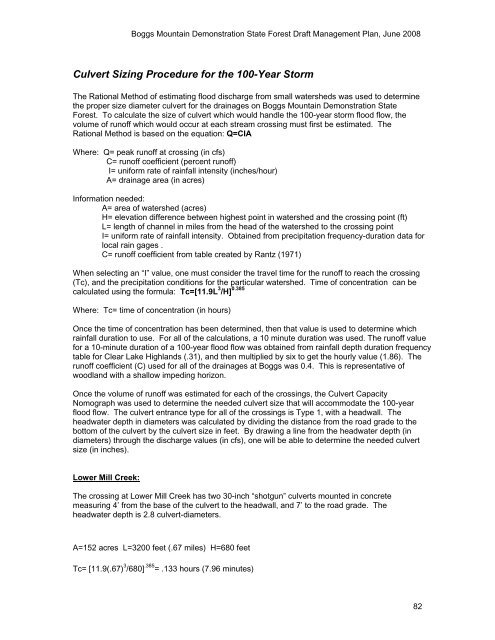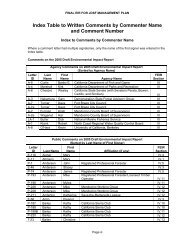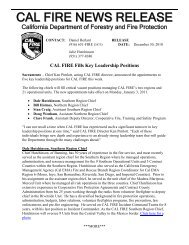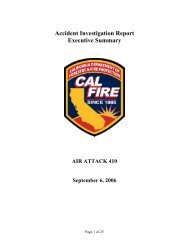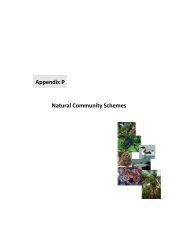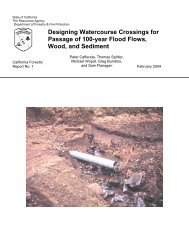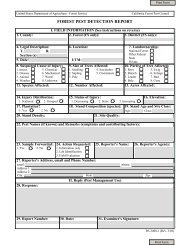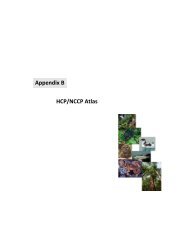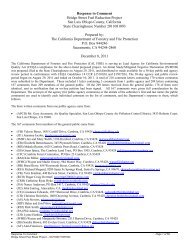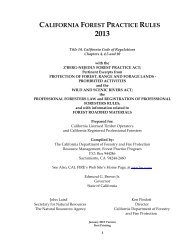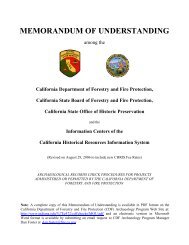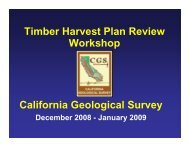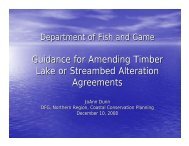Boggs Mountain Demonstration State Forest Draft ... - Cal Fire
Boggs Mountain Demonstration State Forest Draft ... - Cal Fire
Boggs Mountain Demonstration State Forest Draft ... - Cal Fire
You also want an ePaper? Increase the reach of your titles
YUMPU automatically turns print PDFs into web optimized ePapers that Google loves.
<strong>Boggs</strong> <strong>Mountain</strong> <strong>Demonstration</strong> <strong>State</strong> <strong>Forest</strong> <strong>Draft</strong> Management Plan, June 2008<br />
Culvert Sizing Procedure for the 100-Year Storm<br />
The Rational Method of estimating flood discharge from small watersheds was used to determine<br />
the proper size diameter culvert for the drainages on <strong>Boggs</strong> <strong>Mountain</strong> <strong>Demonstration</strong> <strong>State</strong><br />
<strong>Forest</strong>. To calculate the size of culvert which would handle the 100-year storm flood flow, the<br />
volume of runoff which would occur at each stream crossing must first be estimated. The<br />
Rational Method is based on the equation: Q=CIA<br />
Where: Q= peak runoff at crossing (in cfs)<br />
C= runoff coefficient (percent runoff)<br />
I= uniform rate of rainfall intensity (inches/hour)<br />
A= drainage area (in acres)<br />
Information needed:<br />
A= area of watershed (acres)<br />
H= elevation difference between highest point in watershed and the crossing point (ft)<br />
L= length of channel in miles from the head of the watershed to the crossing point<br />
I= uniform rate of rainfall intensity. Obtained from precipitation frequency-duration data for<br />
local rain gages .<br />
C= runoff coefficient from table created by Rantz (1971)<br />
When selecting an “I” value, one must consider the travel time for the runoff to reach the crossing<br />
(Tc), and the precipitation conditions for the particular watershed. Time of concentration can be<br />
calculated using the formula: Tc=[11.9L 3 /H] 0.385<br />
Where: Tc= time of concentration (in hours)<br />
Once the time of concentration has been determined, then that value is used to determine which<br />
rainfall duration to use. For all of the calculations, a 10 minute duration was used. The runoff value<br />
for a 10-minute duration of a 100-year flood flow was obtained from rainfall depth duration frequency<br />
table for Clear Lake Highlands (.31), and then multiplied by six to get the hourly value (1.86). The<br />
runoff coefficient (C) used for all of the drainages at <strong>Boggs</strong> was 0.4. This is representative of<br />
woodland with a shallow impeding horizon.<br />
Once the volume of runoff was estimated for each of the crossings, the Culvert Capacity<br />
Nomograph was used to determine the needed culvert size that will accommodate the 100-year<br />
flood flow. The culvert entrance type for all of the crossings is Type 1, with a headwall. The<br />
headwater depth in diameters was calculated by dividing the distance from the road grade to the<br />
bottom of the culvert by the culvert size in feet. By drawing a line from the headwater depth (in<br />
diameters) through the discharge values (in cfs), one will be able to determine the needed culvert<br />
size (in inches).<br />
Lower Mill Creek:<br />
The crossing at Lower Mill Creek has two 30-inch “shotgun” culverts mounted in concrete<br />
measuring 4’ from the base of the culvert to the headwall, and 7’ to the road grade. The<br />
headwater depth is 2.8 culvert-diameters.<br />
A=152 acres L=3200 feet (.67 miles) H=680 feet<br />
Tc= [11.9(.67) 3 /680] .385 = .133 hours (7.96 minutes)<br />
82


